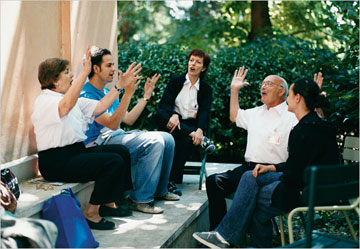
Tino Sehgal rehearsing with interpreters
German artist Tino Sehgal recently spoke about his practice in a discussion with Jens Hoffmann at the California College of the Arts (CCA) in San Francisco. Sehgal has been showing his work in the contemporary art context since 2004. It was in 2005 that Hoffmann curated an exhibition of Sehgal’s work at the Institute of Contemporary Arts in London that caught the attention of the art world. Since then, the duo has remained connected through an ongoing exhibition at the CCA Wattis Institute, where Hoffmann is the director.
I have been interested in the work of Sehgal since reading an article about him in The New York Times in 2007. Examples of Sehgal’s work include museum guards singing “This is so contemporary” in museum galleries (2003) or a couple locked in a passionate kiss (Kiss, 2002), or a person writhing on the ground in the corner of a museum (Instead of allowing some thing to rise up to your face dancing bruce and dan and other things, 2000). Sehgal does not allow any documentation of his work, but the pieces can be purchased nonetheless through passing along oral instructions (if he can’t eliminate capitalistic exchange, at least he can change the nature of what is being exchanged). Sehgal recruits and trains people, whom he calls “interpreters,” to carry out the works.
Sehgal’s work is rooted in two main ideas: 1) sustainability and 2) exploring the “technologies of interconnection.” By using interpreters to carry out his works, Sehgal challenges the conventions of experiencing artwork while also eliminating the waste that naturally comes with object-based work. He cites the events of May 1968 with instilling in him the notion that exchange or transactions needs to be challenged.
I’ve personally encountered two works by Sehgal. The first was Instead of allowing some thing to rise up to your face dancing bruce and dan and other things at the New Museum in the exhibition, After Nature, in 2008. At the opening, there were crowds of people, and most did not notice the woman writhing on the floor in the corner near the stairwell. If you looked at her, she stared back. Her motions were derived from the experimental videos of Bruce Nauman and Dan Graham, but looked more like she was experiencing a seizure or was in pain. You quickly understand that the way you react, internally or outwardly, is part of Sehgal’s work.
Some critics like to trace Sehgal’s work back to the influence of the 1960s Happenings or Fluxus movements or to the Relational Aesthetics work of the 1990s. However, Sehgal’s work takes a significant departure from 1960s performance art in that it is presented in and created for institutions. Sehgal feels more comfortable seeing his work as a trajectory from Relational Aesthetics, in which artists used object-based works to create a dialogue or other type of interaction with the viewer. Sehgal pushes the practice forward by eliminating the object, shifting the focus onto the “technologies of interconnection,” defined by him as the exploration of the space that exists between two people.
Hoffmann is quick to declare that Sehgal’s work is equally as paradigm-shifting as that of Duchamp’s readymade. It is difficult to predict what the next trend or contemporary art movement will be, but it is true that Sehgal is a pioneer in the techniques he employs. As sustainability and the environment become bigger issues, and with the increasingly mediated ways in which humans interact as communications technology continues to develop, perhaps there will be a turn toward Sehgal’s modus operandi.
As a young artist, Sehgal’s work is ever-evolving and is continually-tested. For example, how is the work experienced when the viewer expects to encounter his work? The students at the CCA have the most experience in this, as they have become accustomed to encountering a Tino Sehgal work when they visit the Wattis Institute. Once the expectation of seeing a work of his in the galleries sets in, the space between Sehgal’s work and the viewer becomes more like that of an object-based work and viewer. In response to this reaction Sehgal created, That absence (2009), which was the lack of an interpreter-based work. The regular visitors were, then, preoccupied with where or what the Sehgal piece was in the exhibition.
Sehgal’s next project is a major solo exhibition at the Guggenheim Museum in New York (January 29-March 10, 2010). I am curious to see how Sehgal approaches the exhibition, and how visitors react. A rotation of Sehgal’s work is permanently on view at the CCA Wattis Institute for Contemporary Arts in San Francisco.




Pingback: What’s Cookin at the Art21 Blog: A Weekly Index | Art21 Blog
Pingback: Bruce High Quality Foundation University | Art21 Blog